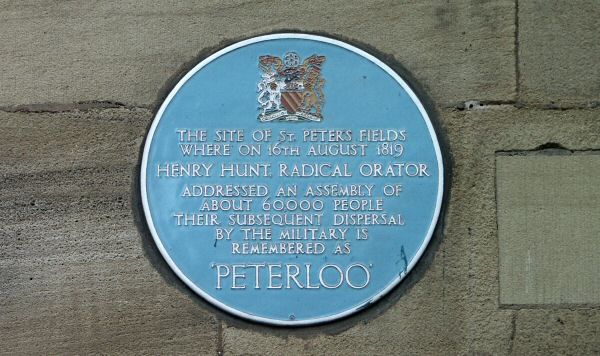

In 1819 only rich property owners could vote. Ordinary people complained about "taxation without representation" and demanded the right to vote. The demand was strong in Manchester, a power house of the industrial revolution, with a large population but little political power. Henry Hunt was one of the most eloquent campaigners. When it was learned that he was to speak at a meeting in Manchester many wanted to hear him.
The government resisted attempts to broaden the vote. They represented people who had a lot to lose and were afraid that the UK may follow the same revolutionary path as France 30 years earlier.
Those in power were troubled by the meeting. In preparation, they assembled four hundred special constables, fifteen hundred infantry, a thousand cavalry (Hussars and Yeomanry), and some Royal Horse Artillery equipped with six-pounder cannon.
At the last moment the magistrates had decided to ban the meeting. They sent 60 cavalry into the crowd to arrest the speakers, then sent in more cavalry to "rescue" the original 60 who had become enveloped in the crush.
Manchester is in Lancashire, but this web site covers the old county of Cheshire. At least three thousand Cestrians crossed the river Mersey on that fateful day, and walked the six miles into Manchester. Many of them were battered and bruised, 50 were seriously injured, one killed:
Over the following year several private individuals put much effort into making an accurate record of the event, and a full list of the serious casualties. The above list is based on their work. It is believed that about 650 people were seriously injured (480 male and 170 female), of whom 18 died. The vast majority of the injuries were caused by sabre, or by being trampled by cavalry.
People in Manchester and surrounding towns were present at Peterloo, or saw the bruised and battered thousands returning home and heard first hand accounts. They learned that newspapers could not be trusted.
The event became known locally as the "Peterloo Massacre". Peterloo, from the name of the field where it took place and the location of the troops' last significant action (Waterloo). Massacre, because the effects of sending a thousand cavalry into an unarmed crowd in a confined space could have been foreseen.
The government's immediate reaction was not to extend the vote, but to pass a number of repressive laws.
| - | The Seditious Meetings Prevention Act prohibited meetings of more than fifty people without the consent of a magistrate. | |
| - | The Training Prevention Act prohibited people from gathering to train or drill. | |
| - | The Seizure of Arms Act allowed magistrates to search any person or property. | |
| - | The Blasphemous and Seditious Libels Act provided stronger punishment for publications that upset the authorities. | |
| - | The Newspaper and Stamp Duties Act increased the scope of the tax on newspapers. | |
| - | The Misdemeanours Act reduced the rights of those facing criminal charges. |
| - | 1832, more male householders, about 4% of adults could now vote, | |
| - | 1867, most men in towns, about 14% of adults could now vote, | |
| - | 1884, most men in the countryside, about 30% of adults could now vote, | |
| - | 1918, almost all men and most women, about 91% of adults could now vote, | |
| - | 1928, almost all women. |
About 99.8% of the adult population of the UK can now vote (UK bureaucracy thrives on exceptions). However, there is still some way to go. Voters elect only one of the two houses of parliament, the House of Commons. The other House, once the hereditary Lords, remains unelected. Most of its members are now appointed by those already in power, a situation that encourages corruption (or suspicion of it) at the highest level in government.